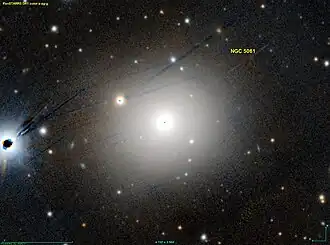NGC 5061
| NGC 5061 | |
|---|---|
 NGC 5061 imaged by Pan-STARRS | |
| Observation data (J2000 epoch) | |
| Constellation | Hydra |
| Right ascension | 13h 18m 05.1444s[1] |
| Declination | −26° 50′ 14.149″[1] |
| Redshift | 0.006945±0.0000630[1] |
| Heliocentric radial velocity | 2,082±19 km/s[1] |
| Distance | 78.54 ± 3.36 Mly (24.080 ± 1.031 Mpc)[1] |
| Group or cluster | NGC 5061 group (LGG 341) |
| Apparent magnitude (V) | 11.44[1] |
| Characteristics | |
| Type | E0[1] |
| Size | ~178,100 ly (54.61 kpc) (estimated)[1] |
| Apparent size (V) | 3.5′ × 3.0′[1] |
| Other designations | |
| ESO 508- G 038, MCG -04-31-048, PGC 46330[1] | |
NGC 5061 is an elliptical galaxy in the constellation of Hydra. Its velocity with respect to the cosmic microwave background is 2,383±28 km/s, which corresponds to a Hubble distance of 114.6 ± 8.2 Mly (35.14 ± 2.51 Mpc).[1] However, 25 non-redshift measurements give a closer mean distance of 78.54 ± 3.36 Mly (24.080 ± 1.031 Mpc).[2] It was discovered by German-British astronomer William Herschel on 28 March 1786.[3][4]
NGC 5061 is a Seyfert II galaxy, i.e. it has a quasar-like nucleus with very high surface brightnesses whose spectra reveal strong, high-ionisation emission lines, but unlike quasars, the host galaxy is clearly detectable.[5]
NGC 5061 group
NGC 5061 is a member of a group of galaxies that bears its name. The NGC 5061 group (also known as LGG 341) contains 10 galaxies, including NGC 5078, NGC 5085, NGC 5101, IC 874, IC 4222, IC 4231, and three galaxies from the ESO catalogue.[6]
Supernovae
Two supernovae have been observed in NGC 5061:
- SN 1996X (Type Ia, mag. 13) was discovered by Robert Evans and Kesao Takamizawa on 12 April 1996.[7][8] At magnitude 13, it was the brightest supernova of 1996.[9]
- SN 2005cn (Type Ia, mag. 14.6) was discovered by the Brazilian Supernovae Search Team (BRASS) on 19 June 2005.[10][11]
See also
References
- ^ a b c d e f g h i j k "Results for object NGC 5061". NASA/IPAC Extragalactic Database. NASA and Caltech. Retrieved 13 August 2025.
- ^ "Distance Results for NGC 5061". NASA/IPAC EXTRAGALACTIC DATABASE. NASA. Retrieved 13 August 2025.
- ^ Herschel, William (1786). "Catalogue of One Thousand New Nebulae and Clusters of Stars" (PDF). Philosophical Transactions of the Royal Society of London. 76: 457–499. Bibcode:1786RSPT...76..457H. doi:10.1098/rstl.1786.0027.
- ^ Seligman, Courtney. "New General Catalogue Objects: NGC 5061". Celestial Atlas. Retrieved 13 August 2025.
- ^ "NGC 5061". SIMBAD. Centre de données astronomiques de Strasbourg. Retrieved 13 August 2025.
- ^ Garcia, A. M. (1993). "General study of group membership. II. Determination of nearby groups". Astronomy and Astrophysics Supplement Series. 100: 47. Bibcode:1993A&AS..100...47G.
- ^ Garradd, G. J.; Nakano, S.; Evans, R. O.; Takamizawa, K.; Kushida, R.; Kushida, Y. (1996). "Supernova 1996X in NGC 5061". International Astronomical Union Circular (6380): 1. Bibcode:1996IAUC.6380....1G.
- ^ "SN 1996X". Transient Name Server. IAU. Retrieved 13 August 2025.
- ^ Bishop, David. "List of Supernovae in NGC and IC galaxies - 1996". Rochester Astronomy. Retrieved 13 August 2025.
- ^ Jacques, C.; Colesanti, C.; Pimentel, E.; Napoleao, T. (2005). "Supernova 2005cn in NGC 5061". International Astronomical Union Circular (8549): 1. Bibcode:2005IAUC.8549....1J.
- ^ "SN 2005cn". Transient Name Server. IAU. Retrieved 13 August 2025.
External links
 Media related to NGC 5061 at Wikimedia Commons
Media related to NGC 5061 at Wikimedia Commons- NGC 5061 on WikiSky: DSS2, SDSS, GALEX, IRAS, Hydrogen α, X-Ray, Astrophoto, Sky Map, Articles and images